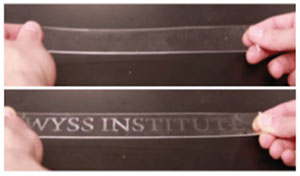Wyss Institute researchers have demonstrated the ability to fine-tune the optical properties of a material by applying varying degrees of mechanical strain — in effect, wrinkling it. The results, reported in Advanced Optical Materials, could herald the development of new types of low-cost dynamic privacy screens, encryption devices, and smart window technologies.

Material scientists have long admired the wrinkling patterns that work various optical wonders in Nature — from the iridescent cuticle of certain beetles, to plum-colored Night tulips that appear black from a distance, to octopi that change their skin color to avoid predators, said lead and co-corresponding author and Wyss Staff Scientist Philseok Kim, Ph.D., who is also a Research Associate at Harvard’s School of Engineering and Applied Sciences (SEAS).
"While we have not achieved Nature’s level of complexity, we are pushing the edge of material design — and we’re very excited about the level of sophistication that we’ve achieved here," said Kim.
The team, led by Wyss Core Faculty member Joanna Aizenberg, Ph.D., who is also the Amy Smith Berylson Professor of Materials Science at SEAS, prepped sheets of PDMS — a flexible and clear silicone-based polymer — with a treatment that oxidizes the material, making it stiff and glass-like. Then they stretched each sheet with varying degrees of intensity — inducing various wrinkling patterns such as stripes, herringbones, and labyrinths. The strain-induced wrinkling patterns give rise to dynamic changes in optical transmittance and diffraction patterns.
The team demonstrated a checkerboard pattern in a simple strain experiment, Kim said – a pattern that had been previously observed in computer simulations only. The checkerboard resulted when a critical strain value was reached upon stretching, and two stripe patterns switched their orientation, becoming orthogonally oriented (i.e., positioned at right angles to each other).

They also encrypted messages that reversibly appeared and disappeared by simply stretching or releasing the material — intimating the potential applications of this mechano-responsive optical material system.
"We are also using the wrinkled PDMS to dynamically control the way light enters a window," Kim added, an advance that holds the potential to dramatically improve the energy and light efficiency of buildings.
The development adds momentum to the progress being made by Aizenberg’s team to develop bioinspired adaptive material technologies that respond to environmental cues like living organisms. In Nature Materials, the team reported the development of a new kind of adaptive material with tunable transparency and wettability features.